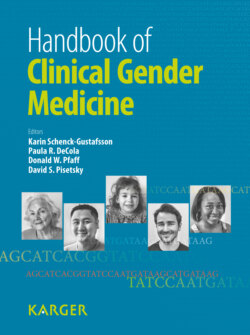Читать книгу Handbook of Clinical Gender Medicine - Группа авторов - Страница 73
На сайте Литреса книга снята с продажи.
Anatomical Aspects of the Insufficiently Developed Genital Tubercle
ОглавлениеMicropenis can be related to failed central hormonal stimulation such has gonadotrophic stimulation or GH stimulation. It can also be the consequence of a poor tissue response (5-α reductase deficiency; partial androgen insensitivity) [22]. Hypospadias is classically represented by the association of a ventrally bent GT, a ventral opening of the urethra at any place between the glans and the perineum, and abnormal distribution of the penile skin. It is the result of a development halt of the tissues forming the ventral aspect of the penis. As a result, the corpus spongiosum, which normally surrounds the urethra, divides creating a ventral triangular defect whose summit is the division of the spongiosum; the lateral sides are the atretic pillars of spongiosum reaching the glans wings, and the open glans forms its base. All of the tissue in this triangle is poorly developed, leading to the ventral curvature of the penis and the poorly formed urethra. Most hypospadias classifications are wrongly based on only the position of the urethral meatus. The GT anomaly is far more complex and its severity must include the size of the GT, the glans, the length of the defective urethra, the quality of the tissues forming the urethral plate, and, moreover, the level of division of the corpus spongiosum. Accurate identification of GT development can only be established in the operating room, once the GT has been fully degloved. One can then distinguish hypospadias with a proximal division of the corpus spongiosum, which are associated with a ventral curvature, from those with a distal division of the corpus spongiosum, which have little or no curvature.
A micropenis is a fully formed GT with a size under 25 mm in length (or under 2-2.5 SD) during the first year of life. It must be distinguished from the buried GT which has a normal size but a significant skin shaft shortage, and from the webbed penis which is the abnormal anchorage of the scrotal skin onto the ventral aspect of the penis [23].
Most deficient GT are diagnosed at birth or in the first few months of life. It is possible to identify some of the most severe anomalies during the prenatal period. Most GT anomalies are straightforward. Conversely, severely hypovirilized GT, in association with other genital anomalies (undescended testes, large mullerian cavity) and discrepancy between the genital aspect and the karyotype, may raise difficult discussions regarding the choice of gender (gender assignment) [24–26]. These rare situations should involve an experienced multidisciplinary team including endocrinologists, geneticists, molecular biologists, psychologists, pediatric urologists, grown-up patients, and, of course, the parents. It is amazing that, at the dawn of the third millennium, one still does not know what makes a boy a boy and a girl a girl. Observational medicine of multiple, and individual, clinical cases is the only tool we have to build the foundations of an approach to the most complex cases. We have learned from these observations that the status of chromosomes, hormones, gonads, the phallus, the vagina, etc., are not sufficient to define a boy or a girl [27]. National and international meetings and think tanks such as the Chicago Consensus Meeting (2005) and EuroDSD have encouraged the exchange of ideas, data bases, research programs, and publications [28].
